I have been highly impressed by the Oase Biomaster Thermo 250 canister filter. This is the first time that I have ever used this brand of filter and so I really had no idea what to expect.
For over a month, I ran this filter on a 70 gallon horse trough in my barn that I’ve converted to a grow out tank for angelfish fry.
In this review, I share my results after testing the GPH, noise, and general maintenance.
Review Overview
This Oase Biomaster does a great job of filtering the water. It comes with tons of reusable sponges that work well for catching fish waste and other gunk.
Plus, it includes unique features, like an integrated heater, a sturdy handle on the motorhead and biomedia that’s like a cross between bio balls and ceramic noodles. I was very interested to see how these would pan out.
The Biomaster Thermo performed well. My water parameters were consistently healthy throughout the testing period, the water clarity was excellent and the heater maintained a steady temperature despite radical swings between day and night temperatures out in my barn.
Installation, priming and maintenance are all simple with this Oase filter. I highly recommend it and just love the integrated heater.

Last update on 2024-04-19 / Commissions Earned / Images from Amazon Product Advertising API
How was the Oase Biomaster Thermo 250 Tested?
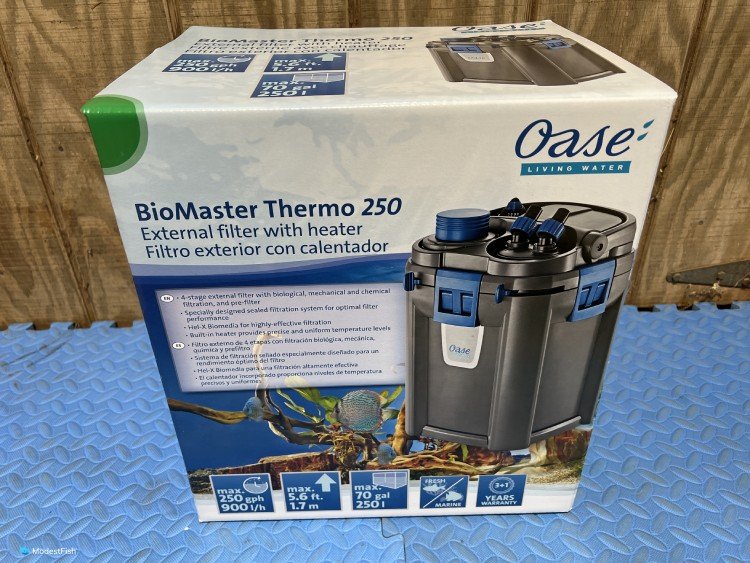
I set this Oase filter up to run on a 70 gallon horse trough that I am currently using as a grow out tank for juvenile angelfish that I bred in my home aquariums.
I was especially focusing on the following criteria:
- Installation – how difficult was it to install this filter?
- Priming – how hard was it to get this filter primed during initial install and after maintenance?
- Performance – was this filter able to maintain healthy water parameters? How was the water clarity during testing?
- Maintenance – what is it like to perform routine maintenance on this filter?
- Noise – how many decibels of sound does this filter produce?
- Temperature control – was the built-in heater able to maintain a consistent water temperature in the tank?
- GPH testing – how much water does the filter move in an hour?
I let this filter run for several weeks, and then took it apart so I could experience what it’s like to perform routine maintenance on this model.
Angelfish need a consistent temperature between 77°-82°F (25°-28°C), especially if you’re trying to get them to grow quickly. I set the temperature on the heater’s dial to 80°F (27°C) and then monitored the temperature several times a day throughout the testing period.
I also tested how many gallons per hour (GPH) the filter pumped out. I diverted the outflow of the filter into a 2 gallon (7.5 liter) container and timed how long it took for the container to fill with water.
I did this three times and calculated the average time from those measurements.
Then, I divided that average by 2, that gave me the gallons per second. I then took that number and used it to divide 3600, the number of seconds in an hour, to find the gallons per hour.
What’s in the Box?
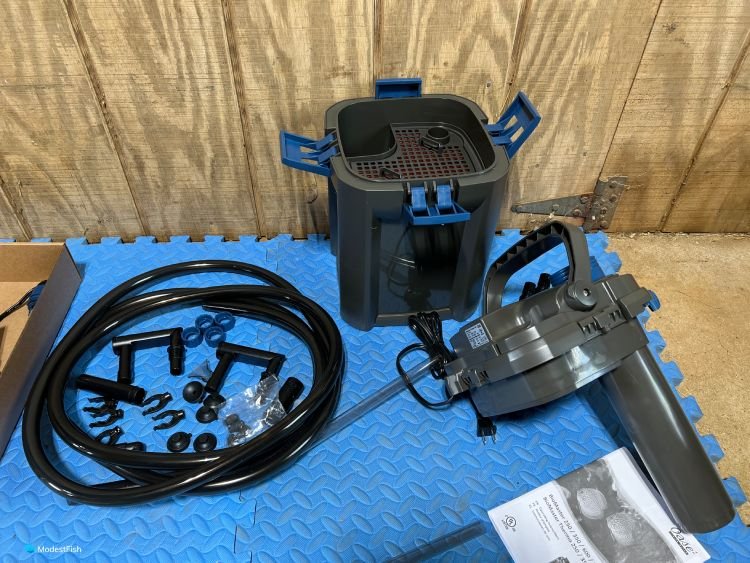
There’s quite a bit to unbox with this filter!
- Motorhead
- Canister body
- Glass heater with attached cord
- Hoses and fittings
- Lift tube with strainer
- Spray bar
- Directional nozzle
- Suction cups
- Instructional manual
The heater has a separate power cord, so you will need to have two open electrical outlets, one for the filter motor and one for the heater.
So, let’s take a look at the criteria I set forth earlier:
Installation
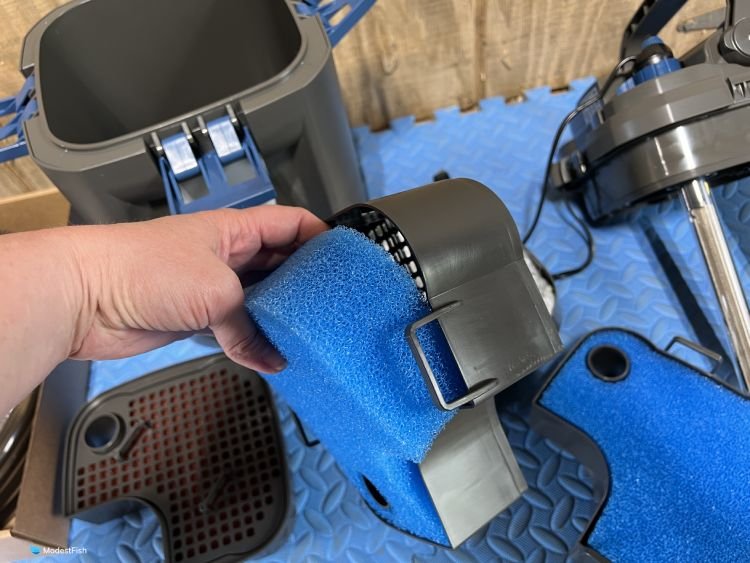
Getting this filter installed was very simple, but also, a bit different from other canisters I’ve put together.
As soon as I opened the box, I was immediately impressed by the big, sturdy handle that’s on the motorhead. I wish all canister filters had this feature! (hint, hint Fluval!)
This filter also features a pre-filter that none of the other canisters I’ve tried included. It’s basically a tube that attaches to the underside of the motorhead.
Inside, it’s a stack of the same kind of small, round sponges that are often used as pre-filters for hang-on-the-backs. This is meant to catch detritus and gunk before it enters the main canister body.
Another unique feature is the integrated heater. This model of Oase Biomaster comes with a 200 watt glass heater that attaches to the motorhead and protrudes down into the main canister body.
I like this for several reasons.
I have lost several fish to heater burns. It especially happens when nano fish try to dart behind the heater as a group.
If the heater is on, all it takes is a split second of contact to seriously, or even fatally, injure a fish.
I lost an entire school of baby Praecox rainbow fish before I figured out they were burning themselves on the heater. It was awful.
I’m a big fan of heater guards to prevent this, but eliminating the danger of having the heater in the tank altogether? That is a major score for me.
Also, this ensures that there is always plenty of water flow over the heater. That allows for more even heating of the water column.
Plus, it’s one less piece of equipment you have to look at in the tank!
I’m always trying to minimize the appearance of support equipment in the display tank so my eye focuses more on the fish and plants, and less on an ugly heater stuck to the back wall.
With this setup, you don’t have to look at the heater at all, totally awesome!
You can remove the heater from the motorhead and replace it if need be, so no worries, a cracked heater won’t mean you have to replace your whole filter.
Glass heaters can crack and cause injuries. Make sure to be cautious during installation and maintenance. Follow all the manufacturer’s safety recommendations. Unplug the heater and give it time to cool down before you pull it out of the water.
The main canister body is divided up into four stacking baskets. Three of them are taken up by large, reusable sponges, and the fourth, contains a unique biomedia that I haven’t seen used in any other filter.
I would describe it as a hybrid between plastic bio balls and ceramic noodles. The pieces are shaped like a ceramic noodle but they are made from an opaque white plastic. Each piece is covered, both inside and out, with ridges and folds to increase the surface area.
This should provide lots of nooks and crannies for beneficial bacteria to grow on.
I mixed this new media with seasoned ceramic noodles that came out of a previous filter. I did this to ensure that there were plenty of beneficial bacteria to keep the cycle going in the tank.
Normally, I complain that canister filter manufacturers don’t provide enough mechanical media with their filters (except Fluval), but it’s the opposite with this filter. I actually think that too much space is dedicated to mechanical filtration and wish that more biomedia was included.
The sponges can act as a habitat for beneficial bacteria, but you have to be careful to only ever rinse them out in dechlorinated water.
Otherwise, you risk killing off bacteria that you need to process fish waste.
I set the filter up for the way the manufacturer recommended. But for long-term use, I would advise taking out one of the sponges and putting additional biomedia into the basket.
Remember to thoroughly rinse all of your filter media before installation. Media can sometimes hold dust that needs to be flushed out.
Priming
I had a little bit of trouble getting this filter primed, at first, but I’m fairly sure that this was due to some sort of operator error.
There is a large priming button on the top of the motorhead. Once I had everything ready, I pushed the button repeatedly for quite a while, and nothing happened. No water flowed into the canister.
After a few minutes, I removed the hoses and pulled the motorhead off. Everything seemed correct, so I put it all back together.
After I reassembled the filter, I pushed the priming button a few times and water started to flow into the canister.
It then started right up when I plugged it into power.
I was never able to verify why I couldn’t get it started on my first attempt, as I said, it very well could have been my mistake. But, since I did have an issue, I wanted to make sure that I documented that it happened.
I had no issues with priming the filter after I did maintenance. The hoses have a quick disconnect feature that holds water in them. Water just starts flowing back into the canister once you reconnect the hoses. Easy peasy.
Performance
This filter did a great job maintaining water clarity. The canister is loaded with mechanical filtration media to catch particles from the water column.
The pre-filter does a great job grabbing small stuff and the three other reusable sponges in the canister easily trap the solid wastes.
My water parameters remained healthy and steady throughout the testing period. I did water changes weekly, and the filter was easily able to keep up with the fish poop and keep everything healthy.
Maintenance
Breaking this filter down for maintenance was a breeze.
The pre-filter can be unscrewed from the top of the motorhead and cleaned out separately. You can just pop it off and rinse out the sponges in dechlorinated water to clean them.
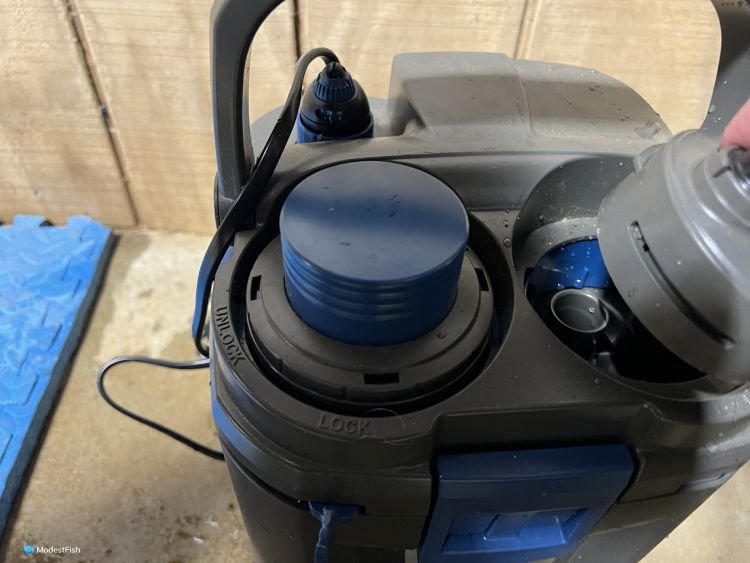
Again, I wish every canister filter on the market had the big handle on the motorhead!!
This simple, yet intuitive, feature makes maintenance SO much easier.
When you lock and detach the hoses, which is very simple on this filter, you can then use the handle to carry the canister body to where you’re going to do the maintenance. It’s usually so awkward to move the canister when it’s full of water. Most canisters are really hard to get a good grip on.
I also liked that the handle made it much more stable when I was removing the motorhead.
Once you’ve got the motorhead off the canister, it’s very simple to pull out the media baskets so you can clean out the sponges. I suggest squeezing out all the sponges in dechlorinated water to wash out debris and goop.
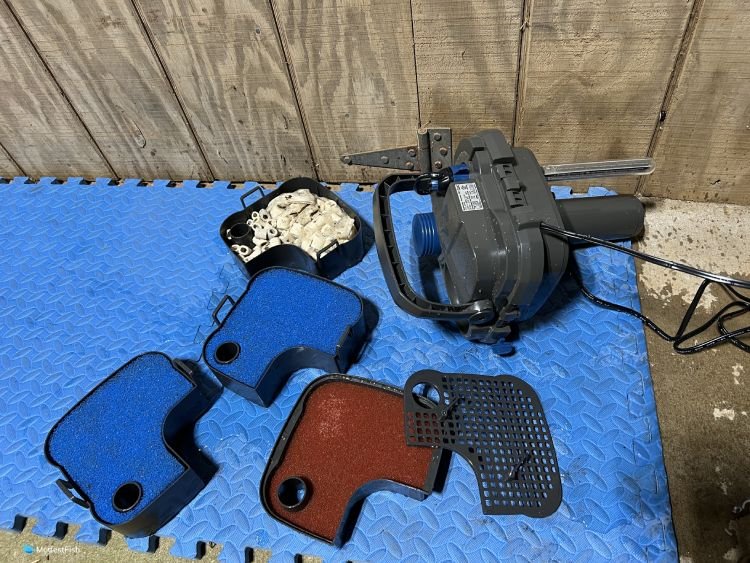
I do have to say, that I don’t like having to stick my hands down in the poop water to retrieve all the baskets. I wish this filter had a central handle that let me pull out all the baskets at once, like Fluval does.
But, this is, in no shape or form, a dealbreaker for me.
Noise
I got an average reading of 44.76 decibels when I used my meter.
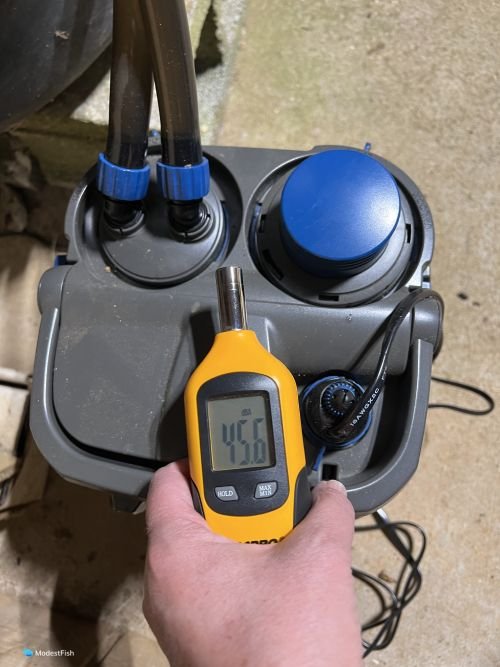
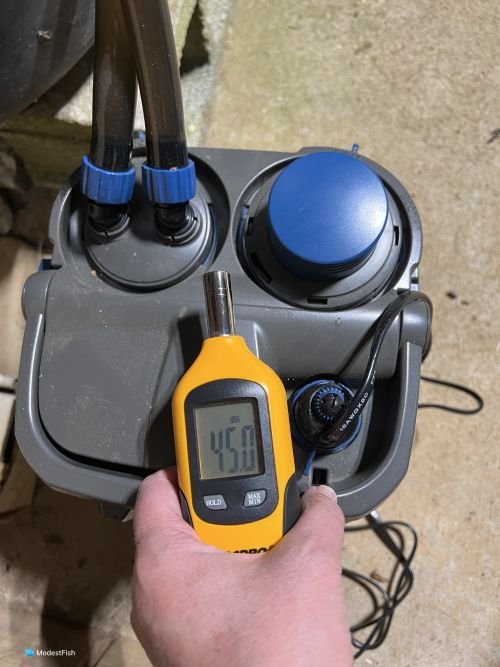
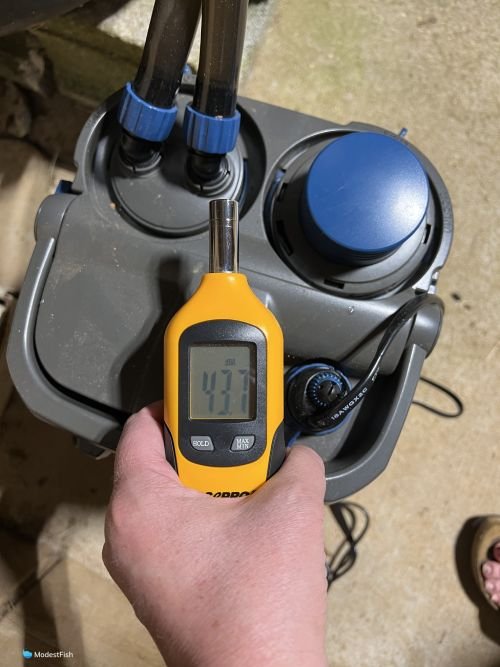
That makes this Oase Biomaster the quietest canister filter I’ve ever tested. The next quietest filter, the Fluval FX6, put out 50 decibels, making it over 3 times louder than this Oase filter.
When I bend down and put my ear close to the canister, I can hear a very slight, slight hum, it’s amazingly quiet.
Temperature Control
I was really impressed by how well the built-in heater was able to control the temperature in the tank. As I said before, angelfish need a temperature around 77°-82°F (25°-28°C).
I set the built-in thermometer to 80°F (27°F) so the water would stay nice and warm.
I kept track of the temperature, checking it a few times a day during the testing period. I was happy to find that the temperature stayed at 80°F throughout this period, even when temperatures in the barn dropped into the high 60s at times.
GPH Testing
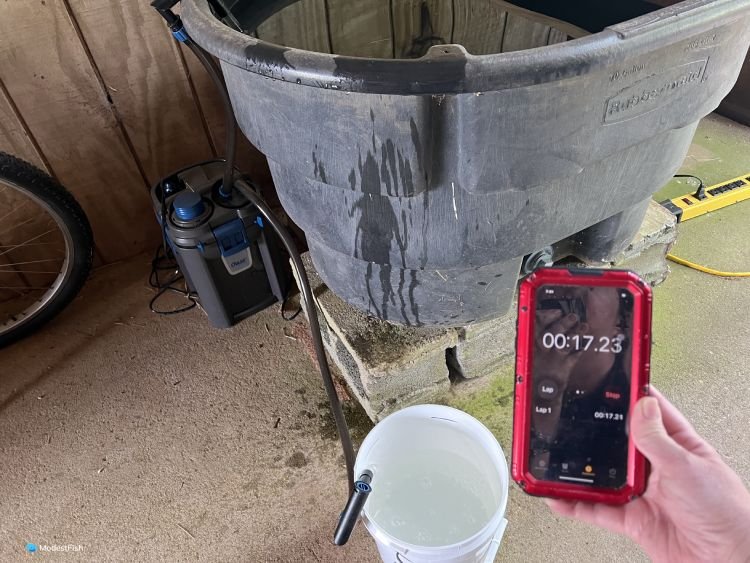
This Oase filter took an average time of 44.38 seconds to fill the 2 gallon container. So, that would be:
44.38 ÷ 2 = 22.19 gallons per second
3600 ÷ 22.19 = 162.24 gallons per hour
The manufacturer rates this filter at 250 GPH (hence the name), but this reflects what the filter’s motor is capable of pumping out all by itself, with no filter media or other obstructions.
As far as I can tell, all filter manufacturers do this. The specs will give the GPH of the motor, but once you add on all the media, the actual GPH ends up being substantially lower.
GPH is also greatly affected by how clogged your filter media is. The dirtier the filter, the more GPH will be slowed down.
With all that being said, given what the actual GPH ended up being, I would recommend this filter for 40-55 gallon (151-208 liter) gallon tanks. I ran this on a 70 gallon (265 liter) tank for testing, but that was on a bare bottom setup that gets 75% water changes every week.
Running this filter on a tank that size long term could be problematic unless you really stay on top of maintenance.
Overall Pros and Cons of Oase Biomaster Thermo
Pros:
- Built in heater
- Sturdy handle on the motorhead
- Excellent mechanical filter media
- Unique biomedia design
- Tons of mechanical media
Cons:
- Not as much space dedicated to biomedia as other filters

Last update on 2024-04-19 / Commissions Earned / Images from Amazon Product Advertising API
How Does the Oase Biomaster Thermo 250 Compare to Others?
I really think that this Oase Biomaster holds up well when compared to other filters in its class.
First off, I’d like to acknowledge that this filter has two unique features that none of its competitors have at all:
- Built in heater – this eliminates the need for a heater inside the display tank and provides safe and consistent water temperatures.
- Sturdy motorhead handle – this handle makes it SO much easier to move the canister when it’s full of water. The handle gives you more stability when you’re removing the motorhead from the canister body. I wish every canister filter had this feature.
When it comes to mechanical filtration, only Fluval filters, like the FX6 and 407, can compare to this Oase Biomaster. This filter dedicates most of the canister to reusable sponge, so there’s plenty of media to trap wastes and detritus.
I do wish that there was more room in the canister dedicated to biomedia. Of course, you can remove one of the sponges to add more biomedia on your own. I’m just commenting about the default setup out of the box.
There is much more room for biomedia inside filters like the Fluval FX6 or 407, the Marineland Magniflow and the Eheim Classic. The Fluval filters especially strike an excellent balance of mechanical vs. biomedia.
The Oase Biomaster had the lowest decibel reading that I’ve ever recorded from a canister filter, surpassing even Fluval’s super quiet canisters.
I was amazed.
Who is the Oase Biomaster Thermo 250 Best For?
After testing the GPH, I would recommend this filter for 40-55 gallon aquariums.
I loved the built-in heater on this Oase filter, a unique feature that none of its competitors has.
I would especially recommend it to anyone with small or delicate fish in the tank. Having a built-in heater can protect tiny fish from coming in contact with a hot surface that can injure or even kill them.
Ironically, I would also recommend this filter for anyone who has large, boisterous fish in the tank, like a school of marauding cichlids.
Bigger fish can crash into a heater, knocking it loose or even breaking it.
The built-in heater in this Oase filter will remain safely tucked away inside the canister and won’t get banged into the next time there’s a tussle in the main part of the tank.
I also think this filter would be great for anyone who has to stuff their canister filter into a tight and/or awkward space. The handle on top of the motorhead makes it very easy to grab onto this filter and pull it out for maintenance.
This Oase Biomaster performed really well during testing. It maintained excellent water parameters and water clarity. And it did a great job of capturing wastes from the water column.
This was my first experience with this brand, and I must say, overall, I was quite impressed.
I hope you find this article helpful.
I wish you and your fish the very best!

Last update on 2024-04-19 / Commissions Earned / Images from Amazon Product Advertising API

You convinced me! This is a great, yet fair and balanced article. I will be going with this brand, but a size or two up because I must add a CO2 reactor to the setup. Many thanks!